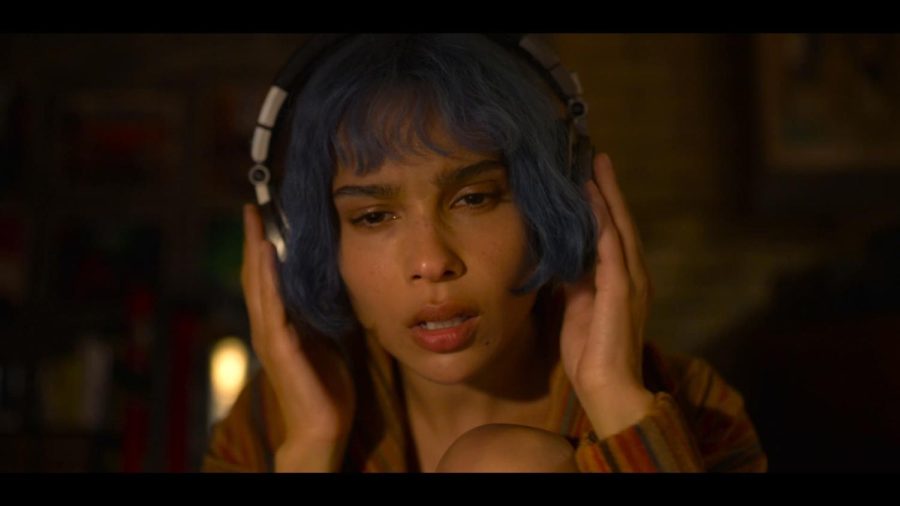Mental Illness and its Representation in Media: Kimi (2022)
Zoë Kravitz playing Angela Childs
October 7, 2022
Kimi (2022) vindicates irrational fears, leading many to consider their mental state. Now streaming on HBO Max, viewers are introduced to Angela Childs, played by Zoë Kravitz known for her role in The Batman (2022) as Selina Kyle. Childs is a young woman suffering from debilitating agoraphobia after being assaulted. With peculiar cinematography and character acting from Kravitz, the movie–Beautiful framing, and color-tinted lenses captivate and breathe life into the anxious, yet bold personality of Angela.
Often a complication sprouting from panic and anxiety disorders, agoraphobia is the fear of situations where withdrawal is difficult or of public spaces where one feels vulnerable. This can include everyday areas such as schools, farms, grocery stores, public bathrooms, libraries, public transport, and much more. To be in these circumstances as an agoraphobic person can cause extreme distress and even physical sickness. This disorder has most recently been shed light on in Kimi, but there are many other examples of the illness in the media. For instance, Bo Burnham’s comedy special Inside (2021) focuses on the agoraphobic tendencies and mental health issues many have equipped as a result of quarantine and COVID-19. Kimi, however, delves into the anxiety surrounding advanced technology and its presence in common areas, a prevalent worry in the digital age. Increasingly so as phones and AI become progressively cutting-edge. So much so, the smallest working computer is nearly invisible to the naked eye, as a grain of rice towers over it. We see the adverse effects of such an illness as Childs develops an inflamed gum, only willing to zoom-call the dentist and refusing to come to his office to get it looked at. Prepared to suffer through a toothache, and possibly an abscess instead of going outside, truly putting in perspective the absolute horror she feels when faced with the outdoors.
Angela works for the fictional company that runs the AI, Kimi. Kimi is a voice-activated home assistant, doing such tasks as adding to a shopping list, playing music, answering questions, and doing other chores. These functions are ominously similar to real-life machines such as Alexa, Google Assistant, Cortana, Siri, etc. The only difference being that they openly moderate failed commands in order to quickly further the AI’s knowledge with humanitarian aid.
Angela Childs is one of these “editors”, going through dialect differences and slurred speech, she comes across the daunting recording of blasted music with screams barely audible. Stunned, she edits the audio to where she can hear a woman, Samantha screaming for a man, Bradley to stop. With her history of abuse, she is especially concerned and locates further files detailing both the confirmation of Samantha’s sexual assault and her murder. The rest of the movie follows Childs as she is forced to come out of her apartment, something we see bring her to her knees at the beginning of the film, for Samantha’s and the future victim’s well-being. Surprising many, the villains of this story are not the AI but the people behind it, making the situation itself more realistic, and chillingly probable, especially so with the backdrop of COVID-19 something we as an audience do not see enough of. The audience then learns Angela is being tracked by the very company that employs her, as we find out Bradley is the CEO of the organization. Her very anxieties become true, men chasing her down hallways and using her phone to locate each and every escape.
Kimi is one of the most beautiful and visually remarkable films out this year, the very posture and, I’ll be it, silly running, with her head down and arms to her side, gives a story in itself of Childs’ nature, a reserved yet controlled persona. Zoë Kravitz’s acting is phenomenal and I truly hope to see her in future films. All while the villains, although home-alone-esque, are frightening enough to imagine oneself in such a situation. So much so, I found myself hovering over the location settings on my phone, envisioning men in black around the corner. Throw-away elements become crucial for the furthering of the plot, checking the box for Chekhov’s gun, and enthralling the audience further as they come to realize the importance of a seemingly ordinary construction site. Overall, Kimi sets a new standard for subsequent films, whether they release in theaters or streaming services. No longer are the times when mediocre films are given praise, for many audience’s opinion on filmography has risen.











